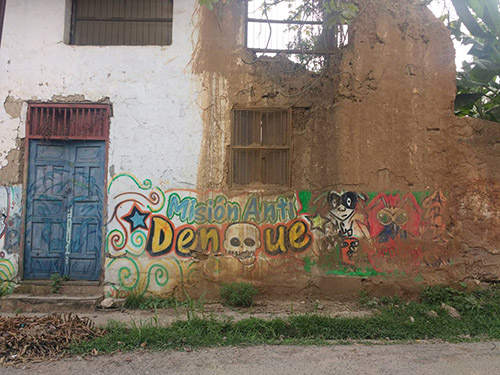Feminist studies in geography, anthropology, and public health have indicated that women do more work during epidemics in terms of prevention and care (Rivera-Amarillo and Camargo 2020). In particular, this text explores two burdens that women have borne during the Zika epidemic: abortion and care for people with disabilities. I will briefly compare the cases of Colombia and Brazil, the countries most affected by Zika in the Americas, drawing attention to women’s bodies and rights, as well as to the debates on reproductive justice that took place during and after the epidemic outbreak that occurred between 2015 and 2016.
Some data on Zika

40-million-year-old Mosquito trapped in amber, from Balkans. Photo by Claudia Rivera-Amarillo
According to reports from national authorities and the World Health Organization (WHO), almost 900,000 cases of Zika have been reported throughout the Americas since 2015. According to bulletins issued periodically by the Colombian National Health Institute, this country has had nearly 100,000 cases, of which more than 95% were reported during the epidemic between 2015 and 2016. During that period, Colombian health authorities reported 18,177 pregnant women infected with the Zika virus, who subsequently gave birth to 16,597 children. Among the latter, official figures reported 356 children with Congenital Zika Syndrome (SZC). Therefore, since 2016, Colombia has implemented the Program of Intensified Surveillance in Pregnant Women with Zika (VEZ) with support from the United States Center for Disease Control and Prevention (CDC). This protocol includes strategies targeting the bodies of pregnant women, as well as guidelines for control, notification, and distribution of responsibilities in terms of surveillance and care. In Brazil, slightly more than 265,000 people have been infected with the Zika virus. According to the Brazilian Ministry of Health, 10% of these cases occurred after the end of the emergency was declared. About 4,700 children have been born with SZC in that country since the beginning of the epidemic in 2015. In addition, there were cases of miscarriage and stillbirth associated with Zika. A surveillance protocol was also established for cases of microcephaly and other alterations of the nervous system.
Compared to the previous year, both Colombia and Brazil have reduced the number of new cases reported between 2019 and 2020. Moreover, the incidence in both countries remains below 0.28 per 100,000 inhabitants. Studies have shown an association between Zika virus infection during pregnancy, SZC, and malnutrition. Between 6% and 12% of pregnant women infected with Zika gave birth to babies with SZC, with 75% of them living in poverty. Among pregnant women whose children developed SZC, 40% had health problems linked to protein deficiencies.
Interventions around Zika from the epidemic to the present have been directed at women’s bodies. The most stringent surveillance, the greatest mobility limitations, and the most significant responsibilities in terms of contraception and care have fallen on women. In other words, women have paid a higher price for the consequences of Zika and, as the study linking SZC to malnutrition shows, it is mainly poor women who bear the burden. While current Zika infection figures are low, it is important we not lose sight of the problems that link women’s bodies, poverty, congenital syndromes, and diseases caused by flavivirus.
For example, recent research has found reason for concern about dengue infection during pregnancy. In addition to increasing maternal death, the chances of neurological malformations in newborns increase by up to 50% if the mother is infected with dengue. This is particularly important at a time when Latin America is experiencing the largest dengue epidemic in history, a health crisis that, at the moment, seems almost as pressing as the current COVID-19 pandemic.
Zika and abortion in the law

Colombian Antimosquito League. Agua de Dios, Colombia, 2019. Photo by Claudia Rivera-Amarillo
Recently, the decriminalization of abortion and the debate over the limit of weeks for legal termination of pregnancy have occupied an important place in the public debate in Colombia. During the Zika epidemic, abortion was an option for Colombian women under local legislation, which decriminalized this practice in the following three cases without imposing a week limit: danger to the mother’s health, non-viability of the fetus outside the uterus, and pregnancy resulting from rape. Although health authorities in that country acknowledged the existence of this option in press conferences, they were cautious in promoting abortion as a public health measure in the case of Zika.
A case of abortion at 32 weeks of pregnancy in April 2016 sparked an intense national debate about the week limit. The pregnant woman had suffered symptoms in the early weeks of pregnancy and was misdiagnosed with dengue fever. Multiple malformations in the fetus, including microcephaly, were discovered in the 28th week of pregnancy. Doctors declared “conscientious objection” to practicing the abortion. A specialist stated that the fetus was viable because it was already in the 32nd week. This produced a public condemnation of the woman, who was accused by some right-wing, conservative, and religious sectors of being a murderer and a Nazi.
In Brazil, abortion is considered a non-punishable crime when the life of the mother is in imminent danger or if the fetus will be unable to live outside the uterus. The links between Zika and microcephaly—known today to be just one of Zika’s neurological complications during pregnancy—gave way to an intense debate that also provided new elements to women’s local struggles around reproductive justice and women’s rights over their bodies. In particular, it was discussed whether the epidemic was not a sufficiently important precedent to reconsider the legislation around abortion.
Disability, functional diversity, and care
Women have also taken on the care labor that the conditions of disability and functional diversity generated by Zika have demanded. Although the public health surveillance protocols mentioned above take into account the SZC and the needs it poses for the future, state actions related to this aspect are few in comparison with other issues. In Colombia, a 2019 study with 192 of the boys and girls declared “SZC-free,” but born to pregnant women with Zika between 2015 and 2016, indicated that 39% had “alterations in the development of hearing and language, 4.6% hemiparesis, 2.7% sensorineural hearing loss and 2.1% complex febrile seizure.” Health services in Colombia operate with a privatized insurance scheme that reinforces structural inequities at all levels. Thus, in the regions most affected by Zika, associations of mothers have emerged, such as Amo a Alguien con Microcefalia (I Love Someone with Microcephaly). These organizations seek comprehensive care for their children with disabilities and support for themselves, as they tasked with both their care and the financial support of their homes. Associations such as Aliança das Mães e Famílias Raras (AMAR) and União de Mães de Anjos (UMA) (Carvalho 2017) have also emerged in Brazil. Despite the fact that the Unified Health System (SUS) is public and universal, mothers and care workers have condemned the profound class inequalities in access to health services and specialized therapies for thousands of children with disabilities that the epidemic left. Gender hierarchies have also become evident in care work, both in the home and in health centers, which is mainly undertaken by women in the more than 15,000 cases of SZC in Brazil since 2015 (Albuquerque et al. 2019).
Conclusion
Not surprisingly, the debate on the decriminalization of abortion has gained momentum again in Brazil and Colombia in the wake of the SZC. The relationship between Zika, neurological disorders, termination of pregnancy, and the number of births has yet to be studied. The current situation of the children who developed SZC in Colombia and Brazil during the epidemic also needs to be studied further. Although these were the countries most affected by the Zika epidemic in the Americas, their surveillance systems are different as well as their management of the epidemic. While the Colombian health system follows a neoliberal model that places responsibility for care on individuals, the Brazilian system is closer to the proposals of Latin American social medicine of the 1970s (Abadía-Barrero 2004). Although this would offer some explanations for the differences I have pointed out, a persepctive inspired by social studies of science and technology that takes seriously gender, sexuality and structural inequalities would provide a more complete and complex picture of the legacies and future of Zika in Latin America.
References
Abadía-Barrero, César Ernesto. 2004. “Políticas y Sujetos Del SIDA En Brasil y Colombia.” Revista Colombiana de Antropología 40: 123–54.
Albuquerque, Maria S. V., Tereza M. Lyra, Ana P. L. Melo, Sandra A. Valongueiro, Thalia V. B. Araújo, Camila Pimentel, Martha C. N. Moreira, et al. 2019. “Access to Healthcare for Children with Congenital Zika Syndrome in Brazil: Perspectives of Mothers and Health Professionals.” Health Policy and Planning 34 (7): 499–507. doi:10.1093/heapol/czz059.
Carvalho, Layla Pedreira. 2017. “Vírus Zika e direitos reprodutivos: entre as políticas transnacionais, as nacionais e as ações locais.” Cadernos de Gênero e Diversidade 3 (2). doi:10.9771/cgd.v3i2.22030.
Rivera-Amarillo, Claudia, and Alejandro Camargo. 2020. “Zika Assemblages: Women, Populationism, and the Geographies of Epidemiological Surveillance.” Gender, Place & Culture 27 (3): 412–28. doi:10.1080/0966369X.2018.1555518.
